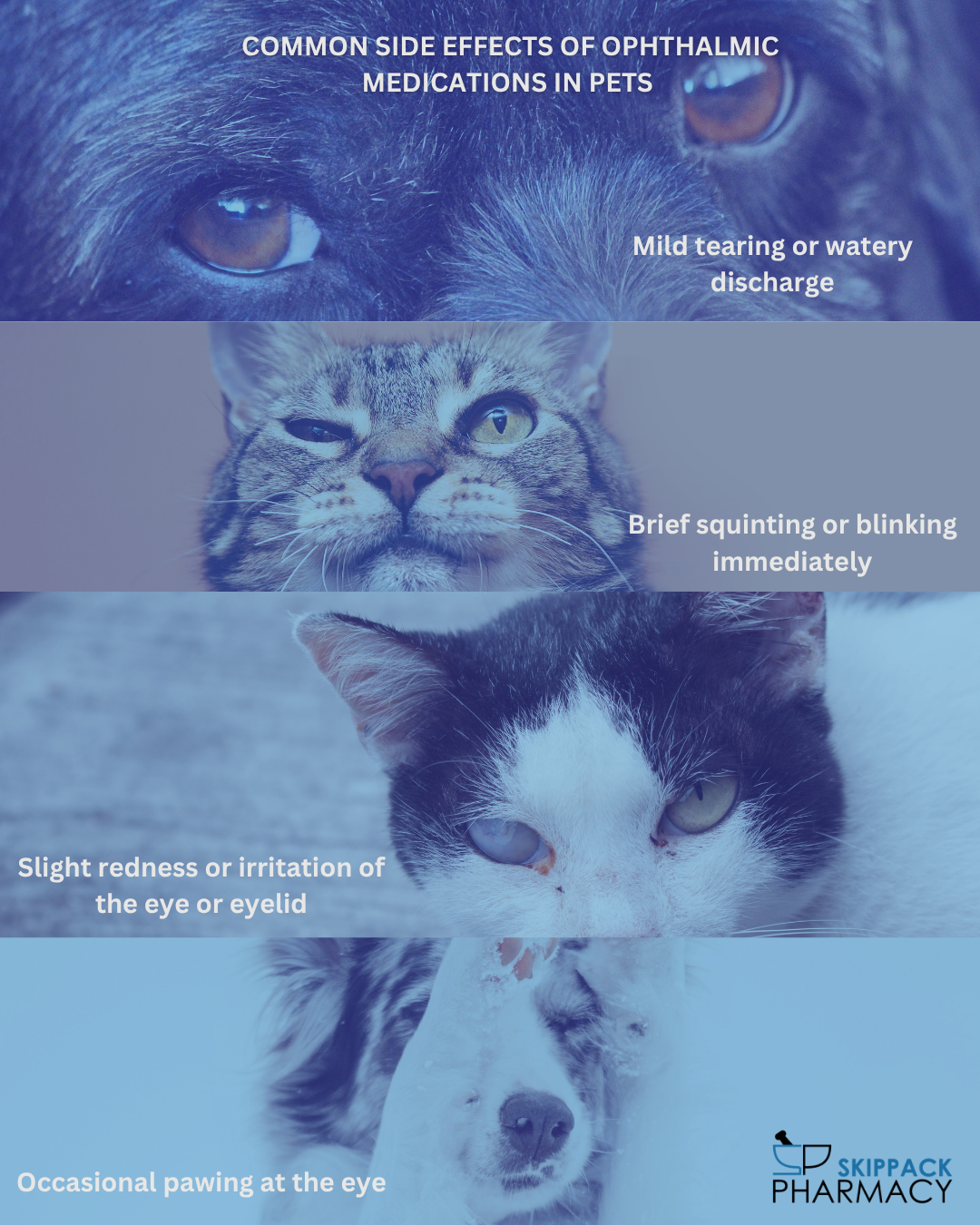
- Pet/Vet
-
by Skippack Pharmacy
Common Side Effects of Ophthalmic Medications in Pets (and When to Call the Vet)
When your pet is prescribed eye drops or ointments, it’s natural to feel unsure about what to expect. Eye medications are essential tools for treating conditions like conjunctivitis, corneal ulcers, dry eye, and glaucoma in animals—but like any medication, they can come with side effects. Understanding what’s normal, what’s not, and when to call your veterinarian helps ensure your pet stays safe, comfortable, and on the path to healing.
How Safe Are Eye Medications for Pets?
Ophthalmic medications used in veterinary medicine are generally safe and well-tolerated when used correctly. Many are specifically formulated for animals, while others are adapted from human medicine. These treatments can include antibiotics, antivirals, anti-inflammatories, lubricants, or pressure-lowering agents, each with its own safety profile. However, the eye is a sensitive organ, and even well-formulated medications can occasionally cause side effects. Side effects may be due to the active ingredient, preservatives in the solution, or simply the discomfort of applying drops.
Mild Side Effects: What’s Normal?
Some side effects are mild and temporary, especially when starting a new medication. These include:
- Mild tearing or watery discharge
- Brief squinting or blinking immediately after application
- Slight redness or irritation of the eye or eyelid
- Occasional pawing at the eye for a few minutes after administering the drops
These reactions usually subside as your pet gets used to the treatment. Unless they persist or worsen, they are typically not cause for alarm.
More Serious Side Effects: When to Be Concerned
While many pets do fine with eye medications, certain symptoms can be a sign of a more serious reaction or worsening condition. Call your vet if you notice:
- Persistent or worsening redness, swelling, or discharge
- Green, yellow, or thick mucus-like eye discharge
- Continued squinting or keeping the eye closed for extended periods
- Visible cloudiness, blood, or color changes in the eye
- Signs of pain, such as head shyness or flinching when the face is touched
- Behavior changes like hiding, lethargy, or loss of appetite
These symptoms could indicate that the medication is irritating the eye, that an infection is getting worse, or that the pet is experiencing an allergic or adverse reaction. Certain medications, like steroids, can even delay healing or worsen infections if used incorrectly.
Special Precautions for Certain Eye Conditions
Some conditions require extra caution. For example, if your pet has a corneal ulcer, your veterinarian may avoid steroid-containing drops, as these can slow healing or increase the risk of perforation. In cases of glaucoma, medications to reduce eye pressure must be monitored carefully to ensure effectiveness.
Always let your veterinarian know if your pet has had eye surgery, is on multiple ophthalmic drugs, or has systemic health conditions that could interact with the medication.
Best Practices for Safe Use
- Follow dosing instructions exactly—don’t increase or skip doses without vet approval
- Avoid touching the dropper or ointment tube to the eye to prevent contamination
- Store medications as instructed, especially those requiring refrigeration
- Never share medications between pets, even if their symptoms seem similar
- Monitor both eyes, even if only one is being treated, since some infections can spread
When in Doubt, Reach Out
If you’re ever unsure whether your pet’s reaction is normal, don’t hesitate to call your vet. It’s always better to check in early rather than wait for symptoms to worsen. Your veterinary team can guide you on whether to continue the medication, adjust the dose, or switch to a different formulation.
Supporting Your Pet’s Eye Health
Ophthalmic medications are powerful tools for maintaining and restoring eye health in pets. By staying informed about possible side effects and red flags, you can play a vital role in your pet’s recovery. With careful monitoring and open communication with your vet, most pets respond well to treatment—and their eyes will thank you for it.

